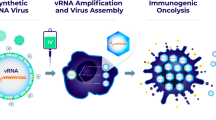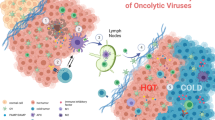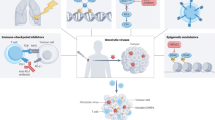Abstract
The efficacy and safety of biological molecules in cancer therapy, such as peptides and small interfering RNAs (siRNAs), could be markedly increased if high concentrations could be achieved and amplified selectively in tumour tissues versus normal tissues after intravenous administration. This has not been achievable so far in humans. We hypothesized that a poxvirus, which evolved for blood-borne systemic spread in mammals, could be engineered for cancer-selective replication and used as a vehicle for the intravenous delivery and expression of transgenes in tumours. JX-594 is an oncolytic poxvirus engineered for replication, transgene expression and amplification in cancer cells harbouring activation of the epidermal growth factor receptor (EGFR)/Ras pathway, followed by cell lysis and anticancer immunity1. Here we show in a clinical trial that JX-594 selectively infects, replicates and expresses transgene products in cancer tissue after intravenous infusion, in a dose-related fashion. Normal tissues were not affected clinically. This platform technology opens up the possibility of multifunctional products that selectively express high concentrations of several complementary therapeutic and imaging molecules in metastatic solid tumours in humans.
This is a preview of subscription content, access via your institution
Access options
Subscribe to this journal
Receive 51 print issues and online access
$199.00 per year
only $3.90 per issue
Buy this article
- Purchase on Springer Link
- Instant access to full article PDF
Prices may be subject to local taxes which are calculated during checkout



Similar content being viewed by others
References
Kirn, D. H. & Thorne, S. H. Targeted and armed oncolytic poxviruses: a novel multi-mechanistic therapeutic class for cancer. Nature Rev. Cancer 9, 64–71 (2009)
Parato, K. A., Senger, D., Forsyth, P. A. & Bell, J. C. Recent progress in the battle between oncolytic viruses and tumours. Nature Rev. Cancer 5, 965–976 (2005)
Liu, T. C., Galanis, E. & Kirn, D. Clinical trial results with oncolytic virotherapy: a century of promise, a decade of progress. Nat. Clin. Pract. Oncol. 4, 101–117 (2007)
Vanderplasschen, A., Hollinshead, M. & Smith, G. L. Antibodies against vaccinia virus do not neutralize extracellular enveloped virus but prevent virus release from infected cells and comet formation. J. Gen. Virol. 78, 2041–2048 (1997)
Vanderplasschen, A., Mathew, E., Hollinshead, M., Sim, R. B. & Smith, G. L. Extracellular enveloped vaccinia virus is resistant to complement because of incorporation of host complement control proteins into its envelope. Proc. Natl Acad. Sci. USA 95, 7544–7549 (1998)
Wein, L. M., Wu, J. T. & Kirn, D. H. Validation and analysis of a mathematical model of a replication-competent oncolytic virus for cancer treatment: implications for virus design and delivery. Cancer Res. 63, 1317–1324 (2003)
Smith, G. L., Murphy, B. J. & Law, M. Vaccinia virus motility. Annu. Rev. Microbiol. 57, 323–342 (2003)
Katsafanas, G. C. & Moss, B. Vaccinia virus intermediate stage transcription is complemented by Ras-GTPase-activating protein SH3 domain-binding protein (G3BP) and cytoplasmic activation/proliferation-associated protein (p137) individually or as a heterodimer. J. Biol. Chem. 279, 52210–52217 (2004)
Yang, H. et al. Antiviral chemotherapy facilitates control of poxvirus infections through inhibition of cellular signal transduction. J. Clin. Invest. 115, 379–387 (2005)
Hanahan, D. & Weinberg, R. A. The hallmarks of cancer. Cell 100, 57–70 (2000)
Mastrangelo, M. J. et al. Intratumoral recombinant GM-CSF-encoding virus as gene therapy in patients with cutaneous melanoma. Cancer Gene Ther. 6, 409–422 (1999)
Kim, J. H. et al. Systemic armed oncolytic and immunologic therapy for cancer with JX-594, a targeted poxvirus expressing GM-CSF. Mol. Ther. 14, 361–370 (2006)
Buller, R. M., Smith, G. L., Cremer, K., Notkins, A. L. & Moss, B. Decreased virulence of recombinant vaccinia virus expression vectors is associated with a thymidine kinase-negative phenotype. Nature 317, 813–815 (1985)
Park, B. H. et al. Use of a targeted oncolytic poxvirus, JX-594, in patients with refractory primary or metastatic liver cancer: a phase I trial. Lancet Oncol. 9, 533–542 (2008)
Hovgaard, D., Mortensen, B. T., Schifter, S. & Nissen, N. I. Clinical pharmacokinetic studies of a human haemopoietic growth factor, GM-CSF. Eur. J. Clin. Invest. 22, 45–49 (1992)
Choi, H. et al. Correlation of computed tomography and positron emission tomography in patients with metastatic gastrointestinal stromal tumor treated at a single institution with imatinib mesylate: proposal of new computed tomography response criteria. J. Clin. Oncol. 25, 1753–1759 (2007)
Byrne, M. J. & Nowak, A. K. Modified RECIST criteria for assessment of response in malignant pleural mesothelioma. Ann. Oncol. 15, 257–260 (2004)
Moss, B. Vaccinia virus: a tool for research and vaccine development. Science 252, 1662–1667 (1991)
Davis, M. E. et al. Evidence of RNAi in humans from systemically administered siRNA via targeted nanoparticles. Nature 464, 1067–1070 (2010)
Peng, K. W. et al. Intraperitoneal therapy of ovarian cancer using an engineered measles virus. Cancer Res. 62, 4656–4662 (2002)
McCart, J. A. et al. Oncolytic vaccinia virus expressing the human somatostatin receptor SSTR2: molecular imaging after systemic delivery using 111In-pentetreotide. Mol. Ther. 10, 553–561 (2004)
Msaouel, P. et al. Noninvasive imaging and radiovirotherapy of prostate cancer using an oncolytic measles virus expressing the sodium iodide symporter. Mol. Ther. 17, 2041–2048 (2009)
McCart, J. A. et al. Systemic cancer therapy with a tumor-selective vaccinia virus mutant lacking thymidine kinase and vaccinia growth factor genes. Cancer Res. 61, 8751–8757 (2001)
Thorne, S. H. et al. Rational strain selection and engineering creates a broad-spectrum, systemically effective oncolytic poxvirus, JX-963. J. Clin. Invest. 117, 3350–3358 (2007)
Thorne, S. H. et al. Targeting localized immune suppression within the tumor through repeat cycles of immune cell-oncolytic virus combination therapy. Mol. Ther. 18, 1698–1705 (2010)
Rozen, S. & Skaletsky, H. Primer3 on the WWW for general users and for biologist programmers. Methods Mol. Biol. 132, 365–386 (2000)
Kulesh, D. A. et al. Smallpox and pan-orthopox virus detection by real-time 3′-minor groove binder TaqMan assays on the Roche LightCycler and the Cepheid Smart Cycler platforms. J. Clin. Microbiol. 42, 601–609 (2004)
Therasse, P. et al. New guidelines to evaluate the response to treatment in solid tumors. European Organization for Research and Treatment of Cancer, National Cancer Institute of the United States, National Cancer Institute of Canada. J. Natl. Cancer Inst. 92, 205–216 (2000)
Choi, H. et al. CT evaluation of the response of gastrointestinal stromal tumors after imatinib mesylate treatment: a quantitative analysis correlated with FDG PET findings. AJR Am. J. Roentgenol. 183, 1619–1628 (2004)
Myers, J. L. W. & Arnold, D. Research Design and Statistical Analysis. 2nd edn, 505–512 (Laurence Erlbaum, 2003)
Acknowledgements
Jennerex Inc. was involved in the study design, data monitoring, analysis and interpretation, and in writing and submission of the report for publication. Jennerex Inc. funded the clinical study. Translational work was supported by grants to J.B. from the Terry Fox Foundation and the Canadian Institute for Health Research (CIHR) and by grants to T.-H.H. from the Korea Healthcare technology R&D Project, Ministry for Health, Welfare and Family Affairs, Republic of Korea (A091047). N.D.S. is supported by a Vanier Scholarship. C.J.B. was supported by a Natural Sciences and Engineering Research Council of Canada (NSERC) studentship. L.E. is supported by Ontario Graduate Scholarships in Science and Technology (OGSST). F.L.B. is supported by a Canadian Institutes of Health Research/Small and Medium Enterprises (CIHR/SME) Collaborative Research Program Fellowship. A.F. and J.C.B. are supported by Ontario Institute for Cancer Research.
Author information
Authors and Affiliations
Contributions
Study design: D.H.K. and J.C.B. Data analysis and study write-up: C.J.B., D.H.K., T.-H.H., A.M., R.P., A.P., T.R., J.C.B. and A.F. Enrolment and management of patients: J.B., D.J., J.S., A.R.H., L.Q.M.C. and J.N. Laboratory work: F.L.B., J.B., N.D.S., S.C., J.-E.J., L.E., Y.-S.L., K.P., J.S.D., M.D. and J.-S.D. C.J.B. and D.H.K. had access to all the data in the trial. C.J.B. and D.H.K. took the final decision to submit for publication.
Corresponding author
Ethics declarations
Competing interests
C.J.B., J.B., A.M., A.P., T.R. and D.H.K. are employees of Jennerex Inc. and hold stock options in Jennerex Inc. T.-H.H. and J.C.B. consult for and hold stock options in Jennerex Inc. R.P., Y.-S.L. and M.D. consult for Jennerex Inc.
Supplementary information
Supplementary Information
The file contains Supplementary Figures 1-4 with legends, a Supplementary Discussion and Supplementary References. (PDF 636 kb)
Supplementary Movie 1
This movie shows the 360° view of a colorectal carcinoma tumour in which vaccinia (JX-594) antigens were detected by immunohistochemistry. Green staining represents areas of tumour staining for vaccinia (JX-594). (MOV 1573 kb)
Rights and permissions
About this article
Cite this article
Breitbach, C., Burke, J., Jonker, D. et al. Intravenous delivery of a multi-mechanistic cancer-targeted oncolytic poxvirus in humans. Nature 477, 99–102 (2011). https://doi.org/10.1038/nature10358
Received:
Accepted:
Published:
Issue Date:
DOI: https://doi.org/10.1038/nature10358
This article is cited by
-
Reshaping the tumor microenvironment of cold soft-tissue sarcomas with oncolytic viral therapy: a phase 2 trial of intratumoral JX-594 combined with avelumab and low-dose cyclophosphamide
Molecular Cancer (2024)
-
Alliance between titans: combination strategies of CAR-T cell therapy and oncolytic virus for the treatment of hematological malignancies
Annals of Hematology (2023)
-
Phase 2 trial of intravenous oncolytic virus JX-594 combined with low-dose cyclophosphamide in patients with advanced breast cancer
Experimental Hematology & Oncology (2022)
-
Randomized phase 2 trial of intravenous oncolytic virus JX-594 combined with low-dose cyclophosphamide in patients with advanced soft-tissue sarcoma
Journal of Hematology & Oncology (2022)
-
CD19-targeted BiTE expression by an oncolytic vaccinia virus significantly augments therapeutic efficacy against B-cell lymphoma
Blood Cancer Journal (2022)
Comments
By submitting a comment you agree to abide by our Terms and Community Guidelines. If you find something abusive or that does not comply with our terms or guidelines please flag it as inappropriate.



